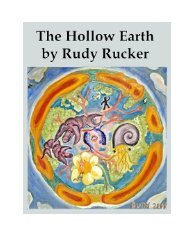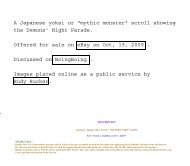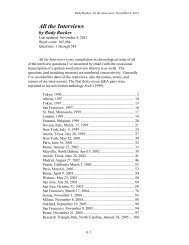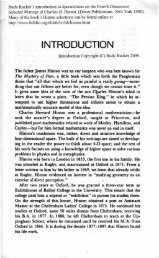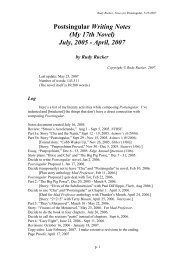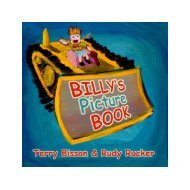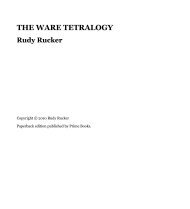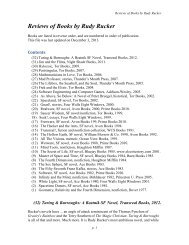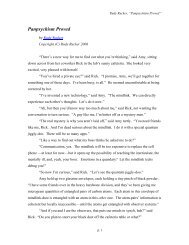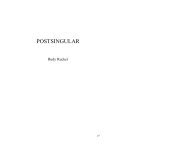Notes for the Lifebox, the Seashell, and the Soul - Rudy Rucker
Notes for the Lifebox, the Seashell, and the Soul - Rudy Rucker
Notes for the Lifebox, the Seashell, and the Soul - Rudy Rucker
You also want an ePaper? Increase the reach of your titles
YUMPU automatically turns print PDFs into web optimized ePapers that Google loves.
<strong>Notes</strong> <strong>for</strong> The <strong>Lifebox</strong>, <strong>the</strong> <strong>Seashell</strong>, <strong>and</strong> <strong>the</strong> <strong>Soul</strong>, by <strong>Rudy</strong> <strong>Rucker</strong><br />
Incomprehensible Solutions<br />
The neural net <strong>for</strong> recognizing smiles <strong>and</strong> frowns, <strong>for</strong> instance, is just a mound of<br />
some three thous<strong>and</strong> real-valued numerical weights. You might hope that if you analyzed <strong>the</strong><br />
weights, you’d discover that each of <strong>the</strong> hidden layer neurons is in fact learning to recognize<br />
a specific aspect of facial expressions. Perhaps <strong>the</strong> first neuron notices whe<strong>the</strong>r <strong>the</strong> left<br />
corner of <strong>the</strong> mouth bends down or up, perhaps <strong>the</strong> second focuses on <strong>the</strong> wrinkles or lack<br />
<strong>the</strong>reof in <strong>the</strong> face’s brow, <strong>and</strong> maybe <strong>the</strong> third pays attention to <strong>the</strong> twist of <strong>the</strong> mouth’s right<br />
corner. But this isn’t necessarily <strong>the</strong> case. In many neural nets <strong>the</strong>re’s no easy way to pick<br />
out what it is that each individual hidden-layer neuron is learning. Indeed, <strong>the</strong> more compact<br />
<strong>and</strong> effective a neural net becomes, <strong>the</strong> more opaque it becomes, <strong>and</strong> <strong>the</strong> less amenable to<br />
human underst<strong>and</strong>ing. [Actually I don’t think this is usually true.]<br />
Unsupervised Learning Raps<br />
Let’s see what happens if we try to think of <strong>the</strong> human brain as being like a computer<br />
scientist’s neural networks. One immediate thing to note is that, because a human is<br />
embedded in <strong>the</strong> world, <strong>the</strong>ir brain network parameters are iteratively refined over <strong>the</strong> course<br />
of years <strong>and</strong> years of parallel computational ef<strong>for</strong>t. Think of <strong>the</strong> finger movements of a<br />
master musician or, <strong>for</strong> that matter, <strong>the</strong> empa<strong>the</strong>tic underst<strong>and</strong>ing of an experienced teacher<br />
or counselor.<br />
It’s useful here to distinguish between two kinds of learning: supervised <strong>and</strong><br />
unsupervised.<br />
Supervised learning is like when I train a neural net with a set of a hundred test faces.<br />
I immediately tell <strong>the</strong> network which answers it got right <strong>and</strong> which it got wrong, <strong>and</strong> <strong>the</strong><br />
network back-propagates <strong>the</strong> errors to carry out a hill-climbing process to adjust its three<br />
thous<strong>and</strong> or so internal weights. Supervised learning is like when you’re learning addition in<br />
elementary school, <strong>and</strong> if you say “Five plus four is eight,” <strong>the</strong> teacher right away says, “No,<br />
five plus four is nine,” <strong>and</strong> perhaps you internally adjust on some neural connections in your<br />
brain.<br />
But most of our learning is unsupervised in that <strong>the</strong> feedback is less immediate <strong>and</strong><br />
direct.<br />
***<br />
Unsupervised learning is when K goes out in <strong>the</strong> playground <strong>and</strong> a girl won’t get off<br />
<strong>the</strong> seesaw to give him a turn, <strong>and</strong> K bites her on <strong>the</strong> butt, but she’s wearing thick snow pants<br />
<strong>and</strong> doesn’t notice, but even so K feels bad <strong>and</strong> dumb. Unsupervised learning is when K<br />
looks <strong>for</strong> someone to marry <strong>and</strong> ends up with <strong>the</strong> girl he tried to bite in first grade.<br />
Unsupervised learning is when K finally tells her that old story <strong>and</strong> she divorces him. Error!<br />
Unsupervised learning is when L drinks so much beer at age sixteen that she throws up,<br />
learns to drink slowly enough not to get sick, but <strong>the</strong>n realizes after thirty years of<br />
increasingly vexed imbibing that she suffers from alcoholism. Unsupervised learning is M<br />
dying of cancer from smoking cigarettes. Back-propagate that! Unsupervised learning is N<br />
laboring in obscurity on a novel <strong>for</strong> fifteen years <strong>and</strong> <strong>the</strong>n selling it <strong>and</strong> having a nice<br />
success. N was right all along!<br />
p. 75



